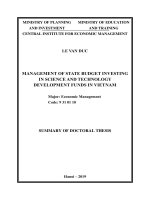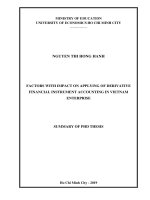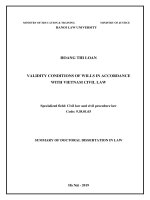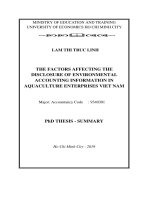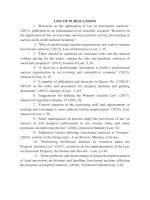Nghiên cứu tác động của chuyển dịch cơ cấu ngành kinh tế đến việc làm trong quá trình tăng trưởng kinh tế ở việt nam tt tiếng anh
Bạn đang xem bản rút gọn của tài liệu. Xem và tải ngay bản đầy đủ của tài liệu tại đây (704.2 KB, 30 trang )
VIETNAM ACADEMY OF SOCIAL SCIENCES
GRADUATE ACADEMY OF SOCIAL SCIENCES
NGUYEN THI DONG
RESEARCHING THE IMPACT OF ECONOMIC
SECTORAL RESTRUCTURING ON EMPLOYMENT
IN THE PROCESS OF ECONOMIC GROWTH IN
VIETNAM
PHÁT TRIỂN HỢP TÁC XÃ VẬN TÀI THỦY-BỘ
NỘI ĐỊA Ở ĐỒNG BẰNG SÔNG CỬU LONG
Major:
Code :
Development Economic
9.31.01.05
SUMMARY OF DOCTORAL DISSERTATION
Hahà ộ
HANOI - 2019
The thesis is completed at:
GRADUATE ACADEMY OF SOCIAL SCIENCES
VIETNAM ACADEMY OF SOCIAL SCIENCES
Supervisors:
1. Assos. Prof. Dr. Nguyen Quoc Te
2. Assos. Prof. Dr. Nguyen Van Luan
Referee 1: Assos. Prof. Dr. Nguyen Chien Thang
Referee 2: Assos. Prof. Dr. Nguyen Thi Nguyet
Referee 3: Assos. Prof. Dr. Ngo Tuan Nghia
The dissertation will be examined by Examination Board of Academy,
at: Graduate Academy of Social Sciences.
The thesis can be found at: - Graduate Academy of Social Sciences’ Library
- National Library
INTRODUCTION
1. Necessity of the research
After a serious domestic socio-economic crisis in the 1980s,
Vietnam decided to comprehensively innovate economic thinking. The
main content of innovation is to abandon the planned economic
mechanism and move to the market mechanism with state management.
Only less than 10 years after “Doi Moi”, Vietnam has made a strong
transition, from being an embargoed and surrounded country, it has
become one of the world's top food exporters. Taking advantage of this
development, in 2001, the Ninth Congress of the Vietnamese
Communist Party set the goal that Vietnam will basically become a
modern industrialized country by 2020. However, 15 years later, at the
11th session of the 13th National Assembly, the National Assembly’s
resolution admitted that the plan had failed.
Vietnam’s failure to achieve the goal of becoming a modern
industrial country by 2020 is due to various reasons. One of the reasons
that can be mentioned is that the selection of growth model in Vietnam
in this period is not clear. Although Vietnam set a target to become an
industrialized country by 2020, Vietnam did not provide specific
orientations to implement it thouroughly. The most important goal that
Vietnamese economy targets in each year and every five-year plan is stil
GDP growth – an index that is not much related to the speed of
industrialization of the country. There seems to be satisfaction with high
growth in the past but there is no good preparation for dealing with
difficulties, which has made Vietnam fall into a “middle income trap”.
Reality shows that while digital resources are growing rapidly, Vietnam
1
is still trying to rely on natural resources to boost the economy.
Therefore, after 30 years of “Doi Moi”, Vietnam’s economic sectoral
structure has shifted towards reducing the rate of agriculture, increase
the rate of industry, but this change is still slow, in which the number of
unskilled jobs is very high.
How does Vietnam get closer to the goal of becoming a modern
industrialized country? Perhaps the first thing Vietnam should do is to
aim for a new growth model: growth based on labor productivity,
associated with creating more high quality jobs on the whole society.
There are many factors affecting employment and labor productivity
growth. However, depending on the different stages of development of
the economy, one or several factors will become the key factor. In the
current period, economic structural change can be considered a leverage
element that stimulates employment growth. Accordingly, when
economic structure is shifted reasonably, similar to the development of
the world economy, labor productivity achieved in each economic sector
will be increased, jobs will be transformed and increased both in
quanlity and quantity. Moreover, the trend of deep globalization and
revolution of technology 4.0 with versions 4.1 and 4.2 is changing the
way of structural transformation of any economy in the connection with
global value chains. In the coming time, the industry structure will be
more closely linked with the technological structure, meanwhile, digital
conversion is always considered as a direct influence on the labor force,
but its effect has never been quantified. Therefore, the relationship
between economic sectoral structural transformation and employment is
considered a complex relationship, but this may be the key to helping the
2
economy achieve its goal of becoming an industrial country in the
shortest possible time, so the author has chosen the topic “Researching
the impact of economic sectoral restructuring on employment in the
process of economic growth in Vietnam” as the research content for the
doctoral dissertation in development economic.
2. Objectives and research tasks of the thesis
2.1.1.
Overall objectives
The basic objective of the thesis is to research the impact of
economic sectoral restructuring on employment. On that basis, the thesis
proposes scientific-based solutions to promote restructuring process
towards creating more quality jobs in Vietnam.
2.1.2.
Research tasks
To accomplish the research objectives, the thesis offers specific
tasks:
- Firstly,
scientifically systematize the relationship
between
economic sectoral restructuring and employment;
- Secondly, using Granger causality test to determine whether the
relationship between economic sectoral restructuring and employment in
Vietnam is one-way or two-way causality;
- Thirdly, after implementing the Granger test, the expected result is
one-way causality, the thesis will continue to use quantitative methods to
evaluate the contribution of economic sectoral restructuring to
employment in Vietnam in two aspects: the number of jobs and labor
productivity;
3
- Fourthly, propose some solutions and policy suggestions to
stimulate restructuring process in Vietnam towards creating more and
more effective jobs for society.
3. Object and scope of research
3.1. Research object
The research object of the thesis is to study the relationship between
economic sectoral restructuring and employment.
3.2. Research scope
In terms of space: the thesis studies this relationship in the whole
territory of Vietnam. In particular, employment is analyzed in two
aspects: labor productivity and number of jobs in the economy; the
economic structure is divided into 3 regions and 17 sectors.
In terms of time: the thesis focuses on analyzing the situation of
Vietnam’s economy in the period of 1991 – 2017 and comparing it with
some other countries in the period that has the same development level as
Vietnam.
In terms of content: the thesis focuses on analyzing the relationship
between employment and economic restructuring by sectors as it is
considered a “pillar” structure. It reflects the level of science and
technology development, production force development and social labor
division. Moreover, the economic structure by region and by composition
in each country is very different. Data collection for these two types of
structures is also not reflected in international statistics, so it is difficult
in quantitative research as well as comparing the level of transfer
between Vietnam and other countries.
4
4. Methodology and research methods
The thesis uses the following research methods: dialectical method;
abstracting science method; descriptive statistics method; comparative
method and econometric method.
For the econometric method, the dissertation uses three specific
methods: (1) Granger causality test is used to measure the relationship
between economic sectoral restructuring and employment; (2) Vector
method and elasticity coefficient are used to consider the impact of
economic sectoral structuring on the number of jobs in the economy; (3)
Shift-share analysis method (SSA) is to used to evaluate the impact of
economic sectoral structuring on social labor productivity.
5. New scientific contribution of the thesis
The thesis has made new scientific contributrions, as follows:
- An overview of the rationale for the relationship between
economic sectoral structural transformation and employment in the
economy;
- Through a number of quantitative methods, the thesis assesses
the contribution level of economic sectoral restructuring to employment
in Vietnam in terms of both quality and quantity;
- The thesis shows the positive impacts, negative impacts and
cause of negative impactd of economic sectoral restructuring on
employment. Since then, there are policy suggestions to promote the
process of economic sectoral restructuring in Vietnam towards creating
more and more effective jobs for society.
5
6. Theoretical and practical meaning
In terms of theory, the thesis selects three mathematical methods to
find out the relationship between economic sectoral restructuring and
employment. This finding will contribiute a part of valuable theory to
improve the analytical framework of economic sectoral restructuring and
employment in Vietnam. Therefore, this will be a solid scientific baisc
for further analysis of relationship between these two factors.
In terms of practicality, based on reliable and up-to-date data, the
thesis will analyze employment status in the process of economic sectoral
restructuring in Vietnam, which may be useful for state government in
designing and implementing policies related to economic sectoral
restructuring and employment.
7. Structure of the dissertation
In addition to foreword and conclusion, the dissertation includes
three chapters:
Chapter 1: Overview of research
Chapter 2: Theoretical background and models to assess the impact
of economic sectoral restructuring on employment;
Chapter 3: Assessing the situation and analyzing the impact of
economic sectoral restructuring on employment through quantitative
methods;
Chapter 4: Orientation and solutions to promote the economic
sectoral restructuring that have a positive impact on employment in
Vietnam.
6
CHAPTER 1
OVERVIEW OF RESEARCH
1.1.
Overview of researchs in the world
The consideration of the relationship between economic sectoral
restructuring and employment has been long long established in may
studies around the world. They all have a common view that the more
economic sectoral restructuring is developed in the modern way, the
more jobs will be created. The dissertation analyzes the overview
according to two contents: theoretical studies and empirical studies.
There have been quite a number of classic theories studying this
relationship, such as Fisher’s labor productivity law (1935); two-area
theory of economists: Ricardo (1871); Lewis (1954), Jorgenson (1961),
Oshima (1989); Harris - Todaro's labor migration theory (1970); Lin’s
new structural economic theory (2010).
In addition to theoretical studies, the relationship between economic
sectoral restructuring and employment is also analyzed in practice
through studies of Ark B. V. (1995), Fagerberg J. (2000), Timmer M. &
Szirmai A. (2000), Nazamuddin (1996), Teal (2011)...
1.2.
Overview of researchs in Vietnam
In Vietnam, studies related to economic sectoral restructuring and
employment are expressed through research topics at the state level,
ministry level; independent studies of group; specialized studies of
international organizations; doctoral dissertations; monographs and
independent scientific articles...
7
CHAPTER 2
THEORETICAL BACKGROUND AND MODELS TO ASSESS
THE IMPACT OF ECONOMIC SECTORAL RESTRUCTURING
ON EMPLOYMENT
2.1.
General theory of economic sectoral restructuring and
employment
2.1.1.
Economic sectoral structure and economic sectoral restructuring
Economic sectoral structure, interms of quantity, is determined by
the rate of output (or GDP) of each part of the total output value (or
GDP) of the entire economy.
Economic sectoral structure, interms of quality, is the whole of
componants that make of economy of each country that are inextricably
linked. These parts interact with each other, represent the quantity and
quality correlation in certain space and time and they are suitable for
certain socio-economic conditions.
The economic restructuring is the process of changing the sectoral
structure from one state to another in the direction of becoming more and
more perfect, suitable for the environment and development conditions.
2.1.2.
Employment
From an economic perspective, employment is concept used to
indicate the appropriateness of labor and necessary conditions (capital,
production materials, technology and other social factors) to use labor.
2.1.3.
The
dialectical
relationship
between
economic
sectoral
restructuring and employment in the process of economic growth
Economic sectoral structural transformation creates the premise for
the for the growth and improvement of production factor markets, such
8
as labor market and financial market. In contrast, perfecting those
markets promotes economic growth and thus deepens the process of
restructuring. However, industry restructuring is a process, not a new
structure is formed at once and immediately replace the old structure, but
the process of economic restructuring must be the process of
accumulation of quantity, changes in quantity to a certain extent lead to
qualitative changes. From the qualitative change, the new sectoral
structure can affect labor – employment, increate labor productivity and
boost economic growth.
2.2.
An overview of theoretical models that relate to the
relationship
between economic sectoral restructuring and
employment
2.2.1.
Law of labor productivity increase, Fisher (1935)
2.2.2.
Two area theory, Lewis – Ranis – Fei
2.2.3.
Two area theory, Jorgenson (1961)
2.2.4.
Three area theory, Oshima (1988)
2.2.5.
Theory of structural change, Moshe Syrquin (1988)
2.2.6.
The main factors affecting the relationship between economic
sectoral restructuring and employment and building an analytical
framework for the dissertation
From theoretical studies, the thesis has examined the following
factors as the main reasons for the rapid shift of economic structure and
become the driving force of economic growth and job creation in the
period of national industrialization and modernization: (1) Institutions
and policies of the state; (2) Capital and progress of science and
technology; (3) Qualifications and capacity of employees; (4) Other
factors: natural conditions, population structure, international integration.
9
PROPOSED ANALYTICAL FRAMEWORK FOR THE THESIS
THEORETICAL BACKGROUND OF ECONOMIC
RESTRUCTURING AND EMPLOYMENT
Theories explain
the relationship
between
restructuring and
employment
The role of
restructuring
and
employment
Factors
affecting
restructuring
and
employment
QUANTATIVE
RESEARCH METHODS
Granger
Causality
Test
Vector
method and
Elasticity
Coefficient
Lessons of
experience about
restructuring and
employment
CURRENT
SITUATION OF
RESTRUCTURING
AND
EMPLOYMENT
Shift-share
Analysis
method
EVALUATION OF THE RESULTS
Evaluation of the
relationship
between
restructuring and
employment
Evaluating the
impact of
restructuring on
the number of
jobs
Evaluating the
impact of
restructuring
on labor
productivity
POLICY SUGGESTION
Group of solutions for
government policies
Group of solutions
10
for business
Group of solutions for
jobs and labor
productivity
2.3.
Methodological
background
of
models
analyzing
the
relationship between economic sectoral restructuring and
employment
2.3.1.
Granger Causality Test
Calling MLI as an economic restructuring variable and GL is a job
growth variable, the causality test between two variables will be
conducted based on the following panel data model:
∑
∑
The verification process will follow the steps:
Step 1
Result:
Homogenous Non-Causality
H0 accepted
Test hypothesis HNC
(test produre stops here)
H0 rejected
Step 2
Test Hypothesis HC
Result:
Homogenous Causality
(test produre stops here)
H0 accepted
H0 rejected
Step 3
Test Hypothesis HENC
Result:
Heterogeneous Non-causality
of i
(test produre stops here)
H0 accepted
H0 rejected
Result:
Heterogeneous Causality of i
2.3.2.
Vetor method and Elasticity Coefficient
The vector method is caculated according to the formula:
∑
√∑
(
[ ]
[ ]
∑
11
[ ])
[ ]
With x[io] and x[it] are respectively the proportion of GDP of sector i
two points o and t; n is the number of sectors in the economy; and φ is
the angle matched by two structure vectors x[io] and x[it]. Combine with
the displacement and cos φ angle, the speed of economic sectoral
restructuring (denote by k, unit: %) will be calculated according to the
formula:
Similar to the formula for calculating the rate of economic
restructuring, calling α is the angle matched by two labor structure
vectors s[i,o] and s[i,t], then the rate of labor restructuring by sector will be:
Combining the shifting rate of economic structure and labor structure
by sector to assess th impact of economic restructuring on employment
for workers through the following elasticity:
2.3.3.
Shift-share analysis method
Assuming the economy is divided into i sectors (i = 1,...,n). Calling
PA is social labor productivity, measured by the total output value (YA)
on the total number of employees (LA), so PA = YA/LA. Similarly, labor
productivity of industry i, Pi: so Pi = Yi/Li. Calling LA is the total number
of employees working and L i is the number of employees working in
industry, then the proportion of working employees in industry i will be
Si, Si = Li/LA. We have the formula:
12
PA
n
Y
YA
i
LA i 1 Li
Li
*
LA
n
Pi * Si
i 1
Differences in social labor productivity between the two period 0 and
T:
n
n
n
i 1
i 1
i 1
PiT Pi 0 Pi o *(SiT Sio ) ( PiT Pi o )*(SiT Sio ) ( PiT Pi o )*Sio
Calling GPA is the speed of social labor productivity growth of the
year T compared to the base year (t = 0), the formula for calculating GP A:
∑
(
)
∑
∑
(
) (
)
(
∑
∑
)
∑
The above equation evaluates the speed of social labor productivity
growth based on three divisions: The first one on the right is the “static
shift effect” that measures the rate of social labor productivity growth
through labor restructuring forwards industries with higher labor
productivity. It uses weighting as the value of labor productivity of the
industry in the first year; The second side shows “dynamic shift effect”,
measuring the rate of social labor productivity growth based on changes
in labor productivity and the speed of labor productivity growth; The
third is “endogenous effect”, reflecting improved labor productivity in
the absence of labor restructuring and the size of working employees in
each sector in the economy is constant during the study period.
2.4.
Experience in implementing economic and employment
restructuring in a nuber of countries and regions
Dissertation analyses Japan, South Korea and Thailand to draw
lessons
for
Vietnam because these countries
have the same
characteristics as Vietnam, whose developmetn is more or less dependent
13
on the marine economy or they all have a starting point from agriculture.
Although each region has its own strengths, Vietnam can fully draw
lessons for themselves through their economic practices.
CHAPTER 3
ASSESSING THE SITUATION AND ANALYZING THE IMPACT
OF ECONOMIC SECTORAL RESTRUCTURING ON
EMPLOYMENT IN VIETNAM
3.1.
Current situation of economic restructuring and employment
in vietnam in the period 1991 - 2017
Dissertation describes the current situation of economic restructuring
and employment in Vietnam in the period 1991 – 2017 in three aspects:
(1) GDP structure by sector; (2) Investment capital structure by sector;
(3) labor structure and labor productivity by sectors in the economy.
3.2.
Assessing
the
impact
of
economic
restructuring
on
employment by quantitative methods
3.2.1.
Using Granger causality test to determine the relationship between
economic restructuring and employment in Vietnam
Statistical description of research data
MLI
Observations
Medium
Maximum
minimum
GL
MLI
1064
1064
Std. Dev.
2.93
2.49
1.72
Skewness
5.74
45.82
16.47
Kurtosis
66.02
0.15
-12.41
Source: Author’s calculations according to GSO data
GL
2.63
0.74
6.74
The results of the first two Granger causality test (HNC and HC)
show that the hypothesis H0 is rejected at latencies 1, 2 and 3 with the
14
level of meaning 5%. At the same time, testing the heterogeeous noncausality (HENC) also supported the existence of th relationship between
GL and MLI.
3.2.2.
Using vector method and elasticity to assess the impact of economic
restructuring on the number of jobs in Vietnam
Application of vetor method and elasticity through the data of the
General Statistics Office of Vietnam in the period of 1991 – 2017 on
working employees by sectors (agriculture, industry, services) and GDP
by sector at constant 2010 prices, the auther calculated the angle of
sectoral restructuring in two parts: restructuring from agriculture to
industry and grom agriculture to non-agriculture. On that basis, the
employment elasticity coefficient is also calculated in two parts: (1)
employment elasticity according to the rate of restructuring between the
two sectors: agriculture – industry; (2) employment elasticity according
to the rate of restructuring between the two sectors: agriculture – nonagriculture.
5
4
3
2
1
1992
1993
1994
1995
1996
1997
1998
1999
2000
2001
2002
2003
2004
2005
2006
2007
2008
2009
2010
2011
2012
2013
2014
2015
2016
2017
0
Employment elasticity according to the speed of economic restructuring
Source: Author’s calculations according to GSO data
15
3.2.3.
Using SSA method to measure the impact of economic sectoral
restructuring on growth of labor productivity in Vietnam
The contribution of restructuring to labor productivity growth is
divided into 5 stages of calculation based on the Government’s 5-year
plans.
Changes in labor productivity in Vietnam overtime
Unit :%.
1996 2000
Stage
2001 2005
2006 2010
2011 2015
2016 2017
1996 2017
Changing rate of component
Static Shift Effect
Dynamic Shift Effect
Endogenous Effect
Labor productivity growth
4.62
11.61
5.76
2.35
0.00
50.42
-0.71
-2.27
-1.51
-0.23
0.01
-9.83
4.32
2.16
15.93
14.16
56.89
13.66
6.41
18.05
14.37
97.48
12.52
16.42
Share of components
Static Shift Effect
28.12
85.03
89.91
13.03
0.00
51.72
Dynamic Shift Effect
-4.34
-16.65
-23.57
-1.30
0.10
-10.09
Endogenous Effect
76.23
31.61
33.66
88.27
98.52
58.36
100
100
100
100
100
100
Total
Source: Author’s calculations according to GSO data
In order to compare the changes in the contribution of effects on the
rate of labor productivity growth by sector over time periods, the thesis
calculates the specific contribution of 17 sectors. The SSA method shows
that internal labor productivity and the process of restructuring in the
period of 1996 – 2017 all contribute significantly to the aggregate labor
productivity, in which, the static effect have played an important role in
the growth of labor productivity at this stage. This is evidence that the
sectoral structural change took place more strongly in the period 1996 2000. In addition, the SSA method shows that some dynamic
16
development sectors will benefit from dynamic effects fo the
restructuring process. Among them, manufacturing industry is the
leading industry. Since 2001, this industry has started to develop and act
as a “modern area” because it has higher productivity and more labor
absorption. Therefore, the dynamic effect in this industry is promoted,
facilitated to motivate the labor productivity growth.
3.3.
The
impact
of
economic
sectoral
restructuring
on
employment
The analysis of the situations and results of quantitative research
presented above leads to the conclusion that economic sectoral
restructuring, on the one hand, has created motivation to promote more
job growth; on the other hand, because the shift did not go to the right
goal, it has led to many new jobs created but low quality and
unsustainable jobs. The cause of negative impacts of economic
restructuring on employment can be include the following factors: (1)
Limitation in design of economic restructuring policy; (2) Shortcomings
in the implementation of investment capital allocation policies for the
process of economic sectoral restructuring in the economy; (3)
Vietnamese enterprises have not focused on innovation; (4) The level of
human resources is still low so it does not meet the requiremnets of
modernization.
17
CHAPTER 4
ORIENTATION AND SOLUTIONS TO PROMOTE THE
ECONOMIC SECTORAL RESTRUCTURING THAT HAVE A
POSITIVE IMPACT ON EMPLOYMENT IN VIETNAM.
4.1. International and domestic context and requirements of
economic sectoral restructuring to have a positive impact on
employment in Vietnam
The world economy is developing in new conditions and contexts
with a profound and comprehensiv transformation in terms of
technological level, product structure and economic institutions. Besides,
the characteristics of the economy with high opening and deep
intergration into the world economic system has created opportunities for
Vietnam to expand its development space quickly and has been strongly
supported by international resources that move increasingly freely.
However, in order for the economic restructuring to be successful in
promoting employment with high labor productivity, there by stimuling
sustainable economic growth in the new contexts, Vietnam needs to meet
the following requirements: (1) Requirements for breakthrough
development in the global value chain through the system of international
labor division; (2) Requirements for seizing opportunities to develop in
leaps and bounds in the era of industrial revolution 4.0; (3) The
requirement of economic sectoral restructuring and employment growth
must always aim at sustainable development.
18
4.2.
Orientation of economic sectoral restructuring to have a
positive impact on employment in Vietnam from now until
2035
Firstly, economic sectoral transformation must be directed towards
integrationand based on integration through effectively exploiting
internal resources, strengthening attraction of external resources and new
creating comparative advantages to improve labor productivity and
national competitiveness.
Secondly, economic sectoral restructuring must be associated with
the building a modern market economy institution to emprove the
effeciency of allocation and use input resources. In particular, it is
necessary to focus on developing the domestic private sector which has
high competitiveness.
Thirdly, economic sectoral restructuring should focus on developing
the innovation capacity of businesses in all sectors and fields in the
economy.
Fourthl, the process of economic sectoral transformation should be
based on high quality human resources and well meet the requirements of
modern science and technology.
Fifthly, economic sectoral restructuring should be associated with
sustainable environmental development and resilience to climate change.
Năm là, chuyển dịch cơ cấu ngành kinh tế phải gắn với phát triển bền
vững về môi trường và tăng cường khả năng chống chịu với biến đổi khí
hậu.
19
4.3.
Some key solutions to promote the economic sectoral
restructuring in order to have a positive impact on
employment by 2035
4.3.1.
Group of solutions on Government policies
Solutions that the government should to address, including: (1)
Building a state that has constructivist capacity to develop quickly; (2)
Applying market principles for economic policies; (3) Developing socioeconomic infrastructure in a perfect way; Sustainable dvelopment
associated with fighting climate change.
4.3.2.
Group of solutions on enterprise innovation capacity
There are two solutions for enterprise innovation, including: (1)
Considering businesses as the center of innovation; (2) Developing an
intellectual property strategy.
4.3.3.
Group of solutions on employment and labor productivity
High labor prductivity and good jobs will be achieved if Vietnam
focuses on implementing solutions: (1) Focusing on investing and
developing human resources to meet the requirements of economic
restructuring and in-depth economic growth; (3) Developing an internal
restructuring strategy towards selecting products based on outstanding
comparative advantages; (3) Strengthen foreign trade opportunities to
deeply participate in global value chain ans stay ahead of competition
with emerging economies.
4.4.
Conditions for implementing the solutions
In the process of economic sectoral restructuring, Vietnam should
create cohesion and linkage between labor resources, infrastructure,
institutions, information, international economic integration and business
20
invironment. More importantly, the prerequisite for Vietnam to become a
modern industrialized country is to have a strong government, run by
elite officials with high education and dedicated spirit, who have
constructivist capacity and a strong political bravery.
CONCLUSIONS
Since Vietnamese economy has entered the period of “Doi Moi” so
far, two issues “economic restructuring” and “employment” have always
been paid attention in most of the 5-year planning periods. This shows
that the government has been very interested in retionalizing the
economic structure. They all have unity in social awareness about the
importance of economic restructuring as well as job creation for workers
to help the economy move from width-based growth to depth-based
growth. Especially, Vietnam is a developing country with a large
population characteristics and popularion structure is concentraded
mostly in rural areas, so the proportion of agricultural labor in th total
labor force is very high. This makes economic restructuring and
employment more and more inevitable to transform into new ways of
growth – growth based on social labor productivity, national resources
and competing capability.
By reviewing a number of studies in the world and in Vietnam to
find research gaps, dissertation has systematized scientifically on the
theoretical background of the relationship between economic sectoral
restructuring and employment and proposed a research framework.
Combining theoretical research and application of several quantitative
methods, the thesis has evaluated the situation and analyzed the impact of
21
economic sectoral restructuring on employment in Vietnam. Analysis
results show that, with Granger causality test, up to 60% of provinces
have supported the impact of economic restructuring on employment.
Among the provinces that do not support this relationship, there are very
developed provinces such as Thu Thien Hue, Khanh Hoa, Ba Ria-Vung
Tau or Binh Duong. Granger causality test results show thay these
provinces represented the opposite relationship with the majority of
above units, meaning employment growth has an impact on economic
sectoral restructuring.
After determining the existence of the relationship between
economic restructuring and employment in Vietnam, dissertation
continued to use vector method and elasticity to measure the impact of
economic restructuring on the number of jobs across development stages.
The results show that the elasticity of employment according to the speed
of restructuring between agricultural sector – non-agricultural sector and
elasticity of employment according to the speed of agricultural sector –
industrial sector have greatly changed, but their value has still increased
over time. This positive change contained a happy signal about the
qualifications of rural workers, that they had good preparation of
necessary skills to be able to meet employment in industrial and service
sectors.
Shift-share analysis is used to measure the impact of economic
sectoral restructuring on labor productivity. The results show that the
internal labor productivity and the process of restructuring in the period
of 1996 – 2017 have made significant contributions to the growth of
aggregate labor productivity in the economy, in which, static effect of the
22
restructuring process has played an important role in the growth of labor
productivity at this stage. In addition, the SSA method shows that some
dynamic development sectors will benefit from the dynamic effects of
the restructuring process. Among them, manufacturing is the leading
industry. Since 2001, the manufacturing industry has begun to develop
and act as a “modern area”, with higher productivity and more labor
absorption. Therefore, the dynamic effect in this area has been promoted,
which has created conditions to govern the growth rate of labor
productivity in the economy.
The analytical results of the dissertation also show that besides the
achievements that have formed strong points, the process of economic
sectoral restructuring also causes negative impacts on employment,
which can be attribited to: Limitation in design of economic restructuring
policy; Shortcomings in the implementation of investment capital
allocation policies for the process of economic sectoral restructuring in
the economy; Vietnamese enterprises have not focused on innovation;
The level of human resources is still low so it does not meet the
requiremnets of modernization.
Based on the results of analysis and evaluation mentioned above, the
thesis has considered the international and domestic context to propose
requirements, orientations and solutions to promote the economic
sectoral restructuring in order to have positive impact on employment in
Vietnam until 2035. Accordingly, the proposed solutions include: group
of government policies; group of solutions on enterprise innovation
capacity; groups of solutions on employment and labor productivity.
23
